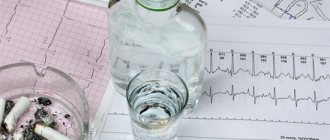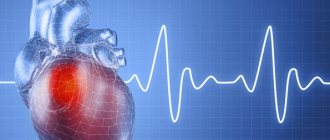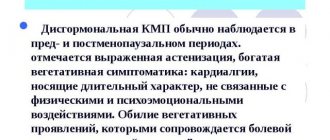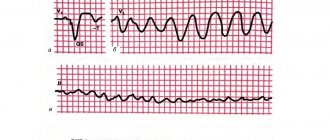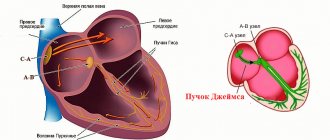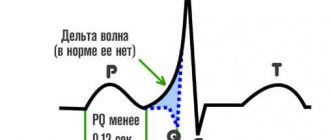Peculiarities
The development of rheumatic carditis occurs in people of any age, but teenagers and young children most often suffer. Before the age of five, the disease occurs in rare cases.
If the disease occurs in a child, it will be much more severe than if it happened to an adult. The disease is accompanied by many symptoms and affects internal organs.
A disorder develops after streptococci enter the body.
How to recognize the rheumatic process?
The very first steps in a diagnostic search are:
- Collection of a rheumatic history, where special emphasis is placed on infections suffered in the recent past;
- Examination of the patient to identify symptoms of rheumatism: polyarthritis, rheumatic carditis, chorea, etc.);
- Auscultation (appearance or intensification of murmurs in the area of the apex of the heart or aorta, rhythm disturbance);
An important role in the diagnosis of rheumatism is assigned to a blood test to determine:
- Erythrocyte sedimentation rate - ESR and leukocyte formula values (usually a detailed analysis is immediately prescribed);
- C-reactive protein (normally negative);
- Titer of antibodies directed to streptococcus (antistreptolysin - ASL-O) and intensively “multiplying” in rheumatism;
- Rheumatoid factor (RF), which is normally negative.
Primary activities also include:
- Taking material from the throat for the purpose of inoculating it and identifying β-hemolytic streptococcus (its presence says a lot);
- Electrocardiogram (an extended P-Q interval indicates a heart defect of rheumatic origin);
- X-ray methods usually provide little information during the first attack of rheumatism, but are used to diagnose changes characteristic of severe rheumatic carditis in children and young people;
- Ultrasound examination (ultrasound), as a rule, establishes the presence or absence of a defect.
Classification
Pathology can occur in the form of:
- Pancardita. This process is very dangerous, as it extends to the entire heart lining. It leads to malfunctions of the organ, impaired contractility, and deterioration of blood circulation. Therefore, the likelihood of cardiac arrest is very high.
- Rheumatic myocarditis. Damage to the muscle membrane is observed, which is accompanied by cardiac failure, which significantly worsens the quality of life.
- Rheumatic endocarditis. The inflammatory process spreads to the inner layer of the heart, causing defects to occur and the tissues to thicken and coalesce.
During its development, the disease goes through several stages:
- Lingering. This problem is detected if it lasts for six months and does not have pronounced manifestations.
- Spicy. The disease appears abruptly, and symptoms increase rapidly. Urgent medical assistance is needed.
- I'll sharpen it up. The pathological process is actively developing, but proceeds moderately. The symptoms are mild and the effect of treatment is insignificant.
- Continuously relapsing. Periods of exacerbation are followed by improvement.
- Latent. The person is unaware of the disease and even the examination does not show any abnormalities. The diagnosis is often made when the defect has already formed.
Rheumatic carditis
Rheumatic carditis is an inflammatory lesion of the muscles and valves of the heart that occurs against the background of a systemic disease of the connective tissue in the body (rheumatism).
A patient with primary rheumatic carditis develops pain in the cardiac region, severe palpitations, shortness of breath after exercise, and general weakness. Joint pain may occur. On auscultation, murmurs are heard and a disturbance in heart rhythm is noted.
To cure rheumatic carditis, the patient must consult a rheumatologist; for certain indications, medical assistance from a cardiologist or cardiac surgeon may be needed.
Taking into account the identified pathological abnormalities in the patient’s body, the following therapeutic methods are used for treatment.
- Non-drug treatment. Bed rest for 2-3 weeks and a diet rich in proteins and vitamins with limited carbohydrates and salt are recommended.
- Drug therapy. Antibiotics, nonsteroidal anti-inflammatory drugs, and glucocorticoids are usually used. To eliminate congestive manifestations of heart failure, diuretics, calcium channel blockers, β-blockers, and cardiac glycosides are used.
- Surgical intervention. It is performed to eliminate the clinical manifestations of heart disease or its complications (heart failure, pulmonary hypertension, angina pectoris, atrial fibrillation).
What diagnostics should be performed for rheumatic carditis?
When communicating with a patient, the rheumatologist gets acquainted with the complaints. Establishes the fact of the appearance of symptoms of rheumatic carditis after a sore throat.
During a physical examination, the doctor observes a pronounced temperature reaction in the patient, pain in the joints (knee, ankle, wrist, elbow) upon palpation.
Auscultation reveals systolic murmurs and cardiac arrhythmias. To confirm the diagnosis, the doctor prescribes:
- general blood analysis;
- bacteriological examination of a throat smear (detection of hemolytic streptococci);
- serological tests (detect elevated titers of streptococcal antibodies in the blood);
- ECG (heart rhythm and conduction disturbances);
- EchoCG (for diagnosing valve pathology).
Consequences of rheumatic carditis
It is important for a patient with rheumatic carditis to seek medical help at the first signs of illness. This is necessary to prevent the development of serious complications - heart defects, atrial fibrillation, heart failure.
Source: https://likarni.com/illness/symptom/revmokardit
Reasons for development
Pathology occurs under the influence of past infectious diseases. Most often it appears under the influence of group A streptococci. Usually complications are diagnosed after tonsillitis, scarlet fever, and sinusitis. With other viruses there are no such consequences. Only this bacterium is capable of producing toxic substances that damage the human heart.
Sometimes, it is a matter of hereditary predisposition to the problem.
Diagnostics
To diagnose rheumatic carditis in the early stages, doctors will need some information from the patient’s life. Such as:
- whether the disease first appeared in childhood or adolescence;
- whether the process of recurrent rheumatic carditis occurred after infectious diseases;
- long recovery from illnesses of an infectious nature.
Examination of the patient is based on focusing attention on:
- pale skin color;
- blue lips, nose or ears;
- swelling of the lower extremities;
- severe shortness of breath;
- heart problems - increased borders, murmurs, weakened heartbeat.
When diagnosing, blood tests are performed - general, biochemical, as well as immune studies.
Diagnostics using devices:
- ECG – determines heart rhythm;
- FKG - to identify characteristic noises;
- chest x-ray;
- Ultrasound of the heart.
Rheumatic carditis is a manifestation of a general pathological process in the body of a person who has suffered an infection caused by group A beta-hemolytic streptococcus, or GABHS infection.
In order to understand what we are talking about, it is necessary to define the terminology. Rheumatic carditis itself, or, in other words, inflammatory changes in the wall of the heart, occurs as a result of rheumatism. Rheumatism refers to complications after GABHS infection that develop in the joints (polyarthritis), the heart (carditis), the skin (ring-shaped erythema) and the nervous system (chorea minor). Currently, the term rheumatism is considered obsolete, and it is often replaced by the concept of acute rheumatic fever (ARF).
rheumatic inflammation of the heart using the example of pericardial damage (pericarditis)
Thus, rheumatic carditis (along with chorea, polyarthritis and erythema annulare) is the main clinical syndrome of ARF.
The result of rheumatic carditis can be the development of acquired (rheumatic) heart defects, most often mitral valve insufficiency, isolated or combined with damage to the aortic valve.
a dangerous complication of inflammatory processes in the heart - damage to the valve apparatus
It can be extremely difficult to identify pathology, so in addition to laboratory tests and auscultation, a number of instrumental studies are carried out.
- The ECG is of particular importance. Using an ECG, the nature of the course of the disease is determined.
- Ultrasound and x-ray are also used.
- In the blood test, special attention is paid to C-reactive protein, rheumatoid factor, and erythrocyte sedimentation rate.
Symptoms
The main symptoms of rheumatic carditis are difficult to accurately describe. The disease will manifest itself depending on which organ was damaged. The disease leads to a significant deterioration in the patient’s well-being:
- There is pain in the joints, the temperature rises, and weakness worries. Such signs appear during a rheumatic attack.
- The rhythm of heart contractions is disrupted and becomes more frequent.
- There is slight pain in the heart area.
- The liver increases in size.
- Heart failure develops, due to which the legs swell, breathing becomes difficult, and a wet cough occurs in attacks.
Rheumatic carditis in children begins to appear several weeks after infection. They become moody, weak, and complain of muscle pain. If the skeletal system is affected, fatigue quickly sets in.
The severity of the manifestations depends on how deeply the heart muscle is damaged.
The main symptom of rheumatic carditis is aches in the joints and body. This is what indicates tissue infection.
Task No. 12 (rheumatism, active phase. Rheumatic polyarthritis.)
A 17-year-old patient was admitted for inpatient treatment to the cardiology department with a diagnosis of rheumatism, active phase. Rheumatic polyarthritis.
During the nursing examination, the nurse received the following data: complaints of fever up to 37.8°C, pain in the knee, elbow, and wrist joints, which are of a volatile nature, discomfort in the heart area, general weakness, and loss of appetite. He considers himself sick for two weeks, and associates the disease with a previous sore throat. The patient sleeps poorly, is anxious, expresses concern about the outcome of the disease, and is afraid of remaining disabled.
the condition is of moderate severity, the skin is clean, the knee, elbow, and wrist joints are swollen, hot to the touch, painful, the skin over them is hyperemic, movement in the joints is not full. There are no pathological changes in the lungs, respiratory rate = 18 per minute. The borders of the heart are not enlarged, heart sounds are muffled, rhythmic, pulse 92 beats/min., blood pressure = 110/70 mm Hg. Art. The abdomen is soft, painless, the liver is not enlarged.
— strict bed rest, diet No. 10;
—complete blood count, general urinalysis, biochemical blood test;
— indomethacin 1 tablet. 3 times a day;
— ampicillin 0.5 4 times a day IM;
—ascorbic acid 1 tablet 3 times a day.
1. Identify needs whose satisfaction has been disrupted; State the patient's problems.
2. Create a nursing intervention plan with motivation.
3. Explain to the patient the essence of his disease and the need for strict bed rest.
4. Teach the patient how to prepare for a biochemical blood test.
5. Demonstrate the BP measurement technique on the phantom.
3. maintain normal body temperature,
4. be healthy,
-unpleasant sensations in the heart area;
—formation of heart disease;
—risk of developing rheumatic carditis;
è The patient’s priority problem: joint pain.
the patient will notice a decrease in joint pain by the end of the 7th day of hospital treatment.
the patient will note the disappearance of pain and restoration of joint function by the time of discharge.
the patient notes the disappearance of pain, swelling, restoration of the functions of the affected joints, and demonstrates knowledge of the prevention of rheumatism. The goal has been achieved.
3. The student demonstrates the correct level of communication with the patient and clearly explains to him the essence of the disease.
4. The student demonstrates the correctly chosen method of teaching a patient to prepare for a biochemical blood test.
5. The student demonstrates on a phantom the technique of measuring blood pressure in accordance with the action algorithm.
Task No. 13 (stomach ulcer, exacerbation phase.)
A 48-year-old patient is undergoing inpatient treatment in the gastroenterology department with a diagnosis of gastric ulcer, exacerbation phase.
During the nursing examination, the nurse received the following data: complaints of severe pain in the epigastric region, occurring minutes after eating, belching of air, sometimes food, constipation, bloating, and single vomiting of the color of “coffee grounds.” The patient considers himself sick for 1.5 years, and the patient associates the deterioration that has occurred over the last 5 days with stress.
condition is satisfactory, consciousness is clear, position in bed is active. The skin is clean, pale, subcutaneous fat is developed satisfactorily. Pulse 64 beats/min. Blood pressure 110/70 mm Hg. st, respiratory rate 18 per minute. The tongue is covered with a white coating, the abdomen is of regular shape, there is moderate tension in the anterior abdominal wall in the epigastric region, the liver and spleen are not palpable.
1. Bed rest, diet No. 1a.
2. FGDS with biopsy, study of gastric secretion.
3. Maalox 1 suspension 3 times a day.
4. De-nol 1 capsule 4 times a day.
5. Platiphylline solution 0.2% 2.0 s.c.
1. Identify needs whose satisfaction has been disrupted; formulate and justify the patient’s problems.
2. Define goals and plan nursing interventions with motivation.
3. Explain to the patient how to properly prepare for FGDS and gastric intubation.
4. Teach the patient how to take prescribed medications.
5. Demonstrate the gastric intubation technique on the phantom.
eat, drink, be healthy, move, work.
- epigastric pain,
.3 general weakness.
.4 development of gastric bleeding,
.7 pyloric stenosis,
Of the patient's problems listed
è priority is pain in the epigastric region.
2. The patient’s priority problem is pain in the epigastric region.
The patient notes that the pain subsides by the end of the 7th day of hospital stay.
the patient does not complain of pain in the epigastric region at the time of discharge.
the patient notes the disappearance of pain and demonstrates knowledge of preventing exacerbation of peptic ulcer disease. The goal has been achieved.
3. The student demonstrates the correctly chosen level of communication with the patient, the ability to competently, accessiblely, and reasonably explain to the patient the rules of preparation and the essence of FGDS and gastric intubation.
4. The student demonstrates the correctly chosen method of teaching the patient how to take prescribed medications and determines the patient’s response to the training.
5. The student demonstrates on a phantom the technique of performing gastric intubation in accordance with the action algorithm.
Is it possible to avoid heart damage when diagnosed with rheumatism? What needs to be done for this? What to do if the disease does affect the main circulatory organ?
Rheumatism is called a systemic disease, because in the absence of properly selected and timely treatment, not only the musculoskeletal, but also the cardiovascular and nervous systems are affected.
If the disease spreads to the cardiovascular system, the victim experiences pain in the chest and joints, nausea, weakness, and complains of difficulty breathing.
The inflammatory process can lead to serious damage to the central circulatory system, including heart disease.
In the articular form of rheumatism, the inflammatory process occurs in several joints at once. As a rule, the largest of them suffer: knees, elbows, pelvis, shoulders, etc.
Without proper treatment, even a common cold can have serious consequences for the body.
The patient experiences weakness and quickly gets tired even with minimal physical exertion. However, the main complaint is pain in the affected joint, which is usually deformed and swollen.
One of the complications of rheumatism can be damage to the nervous system. It is expressed in mood swings, sleep disturbances, and mobility. In this case, sick children are diagnosed with chorea.
Rheumatic inflammation of the heart (rheumatic carditis) can occur in several forms:
- mild (there are only minor lesions of the heart muscle, symptoms are usually absent),
- moderate (there are significant lesions of the heart muscle, the heart is enlarged, the patient is bothered by a rapid pulse, discomfort in the sternum),
- severe (the patient's condition worsens, he complains of pain in the heart, swelling, fatigue).
If the muscular lining of the heart is affected, the patient is diagnosed with myocarditis. The main manifestations of this form of the disease are arrhythmia, shortness of breath, and discomfort in the heart area. Heart failure is often diagnosed.
Pericarditis is damage to the outer tissue lining of the heart, in which the amount of pericardial fluid increases significantly. Patients complain of shortness of breath, chest pain, dry cough, fever, and irregular pulse.
The severity of symptoms in rheumatic inflammation of the heart largely depends on the state of the body’s immune system and the stage of the disease.
With endocarditis, the inner lining of the heart is damaged, which leads to changes in the heart valves. Clinical manifestations of the disease: fever, chills, excessive sweating. The patient may also complain of weakness, headache, joint pain, significant weight loss...
With pancarditis, all layers of the heart are damaged, which is why it cannot function normally. As a result, blood circulation is impaired and cardiac arrest may occur.
The first symptoms of rheumatic carditis usually appear 2-3 weeks after an upper respiratory tract infection. The patient's body temperature rises, he experiences weakness and malaise. Rapid heartbeat and shortness of breath bother you even when doing normal household chores.
Other complaints include arrhythmia, dull, aching pain in the heart, swelling of the lower extremities, and cough.
Upon examination, it is discovered that the size of the liver and heart is significantly increased.
Patients are concerned about shortness of breath and dull pain in the heart
Diagnosis of the disease begins with a survey and examination of the patient.
The patient’s complaints, information about previous diseases, as well as the presence of rheumatism in close relatives - all this will allow the doctor to more accurately make a diagnosis.
The patient will also have to donate blood for general and biochemical tests, and immune status.
The patient will also need to undergo instrumental examinations: electrocardiogram, phonocardia, chest x-ray, ultrasound of the heart.
To prevent the development of serious consequences of the disease, its treatment should be started as soon as possible.
What medications are indicated for rheumatic carditis? First of all, antibiotics (to suppress infection) and non-steroidal anti-inflammatory drugs (have anti-inflammatory, antipyretic, analgesic effects).
In advanced cases, anti-inflammatory hormonal treatment is recommended; in the development of heart failure, cardiac glycosides and diuretics are recommended.
Sanatorium treatment will strengthen all body systems
In the active phase of the disease, patients are recommended to adhere to bed rest. After discharge, they must be registered with a cardiologist and rheumatologist. During remission, outpatient and sanatorium treatment is indicated.
Primary prevention of rheumatic carditis as one of the manifestations of rheumatism is to strengthen the immune system and increase the overall resistance of the body. In order not to encounter the disease, from childhood you need to lead an active lifestyle, play sports, and eat properly and nutritiously.
Treatment
Therapy is prescribed to eliminate the infectious process. They must also completely eliminate its consequences and keep the heart muscle in normal condition.
Therapeutic techniques
Physiotherapeutic procedures are considered an important part of treatment:
- Periarticular tissues and joints are exposed to ultraviolet radiation.
- They use mud therapy, baths, and dry heat.
- Electrophoresis is used to improve immunity.
- To avoid complications due to a sedentary lifestyle and improve blood flow, massage sessions are prescribed.
The patient is recommended to pay more attention to physical therapy. The doctor will determine which exercises are suitable for each individual patient and the duration of the training.
After the acute episode passes, patients are advised to go to sanatorium-resort treatment.
Drug therapy
If rheumatic carditis occurs, drug treatment is carried out in a hospital setting. In each case, an integrated approach is used. Drug therapy includes the use of anti-inflammatory and antibacterial agents. But besides them, other drugs are also prescribed. Treatment may be supplemented by:
- Glucocorticosteroids. They are needed if rheumatic carditis develops rapidly. In mild cases, this group of drugs should not be used.
- Non-steroidal anti-inflammatory drugs with Aspirin. They help fight the inflammatory process. The dosage and duration of therapy is determined by the attending physician.
- Quinolones. If the disease recurs or lasts for a long time, then use Delagil, Plaquenil. Salicylates are used simultaneously with them. The duration of treatment is about two years.
- Cytostatic immunosuppressants. They are also used for frequent relapses, but only if other drugs are ineffective. Laboratory tests must be performed periodically throughout the treatment period.
- Gamma globulin agents. They help prevent the development of sensitization. But the drugs are contraindicated in cases of severe heart failure or active development of rheumatic carditis.
- Diuretics and cardiac glycosides. They are necessary for severe disturbances in the functioning of the heart.
- Vitamins. Large doses of ascorbic acid and rutin are prescribed.
Also read: What is the danger of cardiomegaly?
Medicines should be taken according to a course that is developed individually for each patient. Thanks to this treatment, exacerbations can be avoided. But the patient himself must make a lot of effort. You should lead a healthy lifestyle and be sure to promptly eliminate all foci of the inflammatory process.
Recently, scientists have created many antibacterial drugs for the treatment of rheumatic carditis, but they must be prescribed by a doctor.
A potential problem for a patient with rheumatic heart disease is the increased risk of developing defects. If this complication is observed, then surgical treatment is resorted to. Surgery is possible only when the active phase of rheumatic carditis has passed. The most common procedure is valvuloplasty.
Diet
During treatment, the patient must eat properly. Following a special diet will provide all the body's nutritional needs. Food must contain a sufficient amount of fats of animal and plant origin. These products contain a lot of complete protein. It is important to give up sweets, baked goods, flour products, salt, spices, and caffeine.
You need to eat food in small portions throughout the day. The intake should be about six, but you should not overeat, portions should be small.
Dishes should be prepared only by boiling; there should be no fried food. In order for the body to receive enough vitamins, you need fresh vegetables and fruits. For the normal functioning of the heart, a sufficient supply of potassium in the body is important.
Rheumatic carditis: mechanism of development, signs and manifestations, diagnosis, treatment, prognosis
The prognosis of this disease is determined by the severity of carditis, as well as the rate of progression of chronic heart failure. With timely treatment, full compliance with the doctor’s recommendations, and with full bicillin prophylaxis, left ventricular failure does not progress, rheumatic carditis does not develop again, and the risk of developing heart disease is extremely minimal.
Timely diagnosis plays a significant role in the prognosis.
- A favorable outcome of therapy will be if the early stage of rheumatism is detected, because the heart and organs are affected to a small extent.
- The prognosis for a recurrent process that appears in childhood will be unfavorable.
In most cases, the pathology leads to valve defects. According to statistics, the formation of a defect occurs in 15% of cases.
Complications and prognosis
The most common outcome of rheumatic carditis is destruction of the heart valves. Even if a rheumatic attack occurs once, then in 20% of patients it leads to defects. Scar changes lead to valve stenosis or insufficiency. As a result of damage to the inner lining, blood clots form, which increases the risk of heart attack, stroke or thromboembolism.
A bad situation can also be observed with the pumping function of the heart. This contributes to numerous complications throughout the body. The greatest danger is heart failure, which develops quite quickly. If rheumatic attacks occur frequently, the disease is chronic and complicated by hardening of the heart muscle.
Very often, under the influence of rheumatic myocarditis, an acute disturbance of the rhythm of heart contractions occurs. Such complications can cause cardiac arrest. There is also a possibility of a chronic form of arrhythmia.
The prognosis depends on the stage at which the diagnosis was made and treatment procedures began.
You can count on recovery and the absence of complications if rheumatism is diagnosed early. The disease slightly affected organs and tissues, so the pathological process can be reversed.
An unfavorable outcome is possible if the disease develops in a child and constantly recurs.
In most cases, the disease contributes to heart defects, which affect every fourth patient.
Characteristic signs of pathology
The intensity of the development of symptoms of rheumatic carditis is associated with the location of the inflammation, as well as the intensity of its spread. In adult patients, the disease is characterized by a mild course with slight pain discomfort in the heart area; the main symptom of rheumatic carditis is shortness of breath during exercise and rhythm disturbances.
The development of cardiac pathology in children under 15 years of age is characterized by a more severe course. The child complains of incessant high-intensity heart pain, shortness of breath appears not only during exercise, but also at rest. Describing their condition, patients note a strong heartbeat, constant heaviness in the left hypochondrium, and swelling in the legs.
Each form of rheumatic carditis corresponds to certain symptoms, but the general signs of the disease in the body are as follows:
- bright symptoms of the rapid onset of the acute form appear suddenly within a month after a person has suffered a nasopharyngeal infection;
- pain syndrome from the side of the heart is accompanied by a temperature of up to 38 ° C (long-term or spasmodic), fever;
- cardiac symptoms develop (shortness of breath, increased heart rate, interruptions in organ function), accompanied by swelling of the lower extremities;
- A pathological process in the body is indicated by general signs such as weakness, increased fatigue, lack of appetite, and weight loss.
The most pronounced sign is acute rheumatic carditis, which sometimes lasts up to two months. The disease can occur dryly without pronounced symptoms or with effusion, which is a serous fluid. The serous type of pathology is accompanied by shortness of breath with impaired breathing, swelling of the cervico-facial area, tachycardia against a background of low blood pressure. Damage to cardiac structures in different types of rheumatic diseases is signaled by certain clinical symptoms.
Rheumatic endocarditis
Inflammation affects the valve apparatus, which is accompanied by scarring of the affected cellular structures. Loss of mobility of the membranes leads to disruption of the functioning of the organ, which is manifested by the development of heart defects. The mitral valve leaflets suffer from the inflammatory process, causing myocardial failure, which is diagnosed by symptoms:
- severe weakness and dizziness;
- fainting;
- frequent breathing with cough, shortness of breath;
- manifestations of tachycardia, signs of ascites (fluid accumulation in the peritoneum).
Important: Endocarditis is characterized by rapid pulse with heart pain associated with angina pectoris. But a distinctive feature of a pain surge is long-term pain, regardless of physical activity. The disease is difficult to treat, and a poor prognosis is the most common outcome of this type of rheumatic carditis.
Rheumatic pericarditis
Heart disease is manifested by inflammation of the organ lining and can develop with or without effusion into the cavity of the heart sac. Pericarditis with effusion is signaled by the following signs:
- swelling of the neck and face, nodular rashes on the scalp and hands;
- irregular breathing rhythm, as well as shortness of breath during exertion;
- rapid heartbeat with a sharp drop in blood pressure;
- epigastric discomfort (heartburn, belching) due to stagnation of bile.
While listening to the patient, the physician detects a muffled tone and noise effect associated with pericardial friction. In the dry form of the disease, pain and other noticeable symptoms are usually absent; the appearance of pain is associated with a complication of the disease process.
Rheumatic myocarditis
The development of this type of cardiac pathology is signaled by inflammation of the muscle structures – the myocardium. The disease can develop in a mild form (focal form) or in a severe scenario (diffuse myocarditis). The severity of symptoms is determined by the type of myocarditis; the non-dangerous focal form of the disease is accompanied by symptoms:
- cardiac discomfort at rest;
- various types of arrhythmia;
- sounds of systolic murmur while listening.
The symptoms of the diffuse form of myocarditis are more severe and often lead to death. The onset of an attack is accompanied by changes in the patient’s appearance:
- the face with whitened skin is distorted by a grimace of fear and suffering;
- a person tries to find a position to alleviate the condition;
- the neck veins swell, their strong pulsation is felt;
- the abdominal area bulges due to a malfunction of the liver.
Other signs of a fatal condition include severe shortness of breath, which is accompanied by symptoms of tachycardia, pressing pain in the heart area. It is difficult for a person to move due to weakening of the muscular frame, which can lead to loss of consciousness. A distinctive feature of diffuse myocarditis is periodic hemoptysis with severe febrile syndrome. While listening to the patient, the doctor detects specific murmurs during a galloping heart rhythm, which is manifested by complex signs of changes on the cardiogram.
Important: The most life-threatening form is considered to be recurrent myocarditis of a continuously relapsing type. Inflammation of the heart muscles (myocarditis) with stable rheumosclerosis without exudate progresses slowly, but causes the development of heart failure and liver cirrhosis.
Preventive measures
To avoid the development of the problem, you should undergo timely treatment for streptococcal infections, regardless of the cause of their occurrence. It is especially necessary to fully treat sore throat and rye, since it is these diseases that create favorable conditions for rheumatic carditis. The therapeutic course should be monitored by a doctor, who also selects means to eliminate inflammation and antibacterial drugs.
If rheumatic carditis does appear, its symptoms require medical help. Rheumatic attacks should be avoided. Prevention of this condition is especially important in recurrent forms of the disease. It involves the use of Penicillin. A long course is required. Sometimes lifelong therapy is required.

